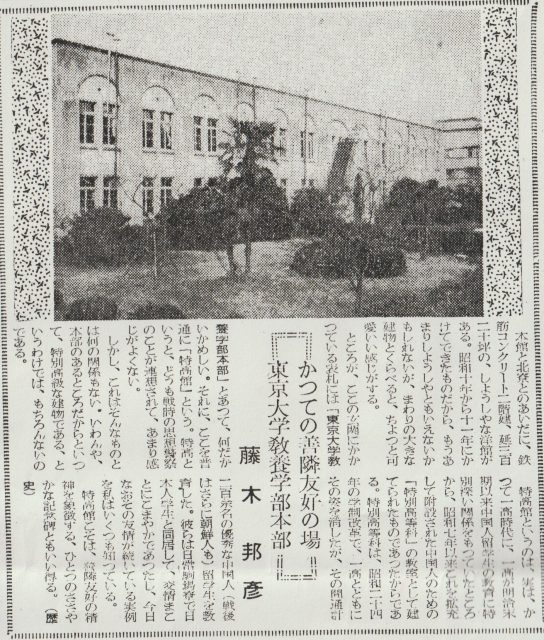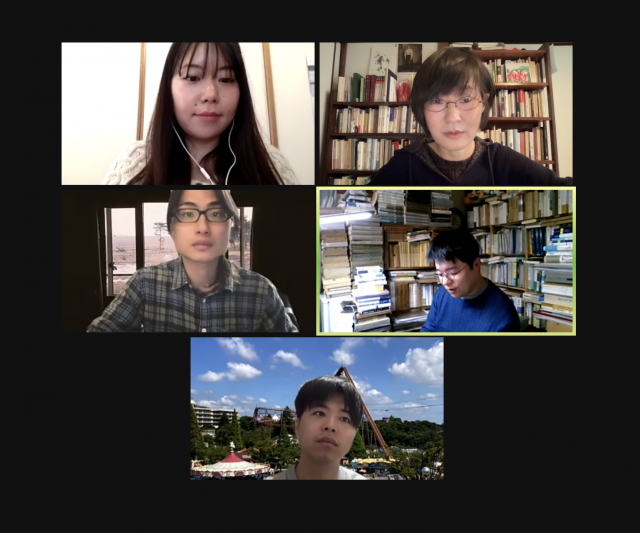The sixth workshop of the Building 101 film production project was held via Zoom on February 26, 2021, from 4 p.m.
The participants in the workshop were Hanako Takayama (EAA Project Assistant Professor) and the three EAA research assistants in charge of the Building 101 film project—Satoshi Takahara, Sho Kotegawa, and Shuichiro Higuma—as well as Sana Sakihama (EAA Project Research Fellow) as an advisor.
Satoshi Takahara started the workshop by introducing the daily records of the former First High School’s dormitory (一高寮日誌). He particularly focused on articles about the sawa-kai (茶話会), a small meeting of Japanese and Chinese students, which described the disagreements or difficulties that existed among the students. Since there are few documents in which we can learn about Chinese students’ own opinions or voices, these records are very valuable.
Following Takahara’s report, Kotegawa Sho shared with us the video that he shot on Komaba Campus, showing the plum trees in front of Building 101 in bloom. In the previous meeting, Tsuyoshi Ishii pointed out that plum is a flower that has symbolized Chinese culture in a similar way to the peony. Inspired by this, Kotegawa chose to shoot footage of the plum blossom on the campus.

After that, Shuichiro Higuma spoke about an academic journal, Tetsugaku-zasshi (『哲学雑誌』), first published in 1887. It includes some reports about classes at the First High School written by professors who taught at both the University of Tokyo and the First High School, such as the neo-Kantian philosopher Genyoku Kuwaki (桑木厳翼, 1874–1946).
To end the workshop, Hanako Takayama showed us a February 1954 article from Kyōyō-gakubuhō (『教養学部報』) written by Kunihiko Fujiki (藤木邦彦, 1907–1993), a historian who taught at the First High School. At EAA, Mizuki Uno (EAA Project Research Fellow) and Satoshi Takahara have conducted archival research on the Fujiki-monjo (藤木文書), the body of documents left behind by Fujiki. He came to the First High School in 1932 and was inaugurated as the chief of the international student office in 1942. He thus held positions at the school from the start of the Second Sino-Japanese War and the Pacific War to the end of these wars.

Kyōyō-gakubuhō, number 28 (February 1954)
In the article, recollecting the days before 1945, Fujiki wrote about the importance of friendship in times of war: “The Special High School Course [特設高等科] was abolished in 1950. Over two hundred brilliant Chinese (and Korean) students had studied at the school. They built friendships with Japanese students through living together in the dormitory. I know that those long-lasting bonds continue to exist even now. The Tokkō-kan [特高館, Building 101] should be a symbol representing good neighborly relations.” As Fujiki wrote in his article, friendship was very important. However, we should not forget that there were surely conflicts among the Chinese and Japanese students. We can easily imagine that some Chinese students were torn between their personal friendships with Japanese students and their desire to fight Japanese imperialism as part of the resistance movement in their homeland. It is important to remember such complexity when we create our film about the history of Building 101.

Reported by Sana Sakihama (EAA Project Research Fellow)








